Blogging is more than just a hobby; it’s how to make money online blogging. With the right strategies, your blog can become a lucrative business.
Many people wonder how to make money blogging. The answer lies in understanding the various monetization methods available.
From affiliate marketing to selling digital products, the opportunities are vast. But success requires more than just knowing the options.
Choosing the right niche is crucial. It helps attract a dedicated audience and sets the foundation for your blog’s growth.
Creating high-quality content is essential. It engages readers and keeps them coming back for more.
SEO optimization plays a vital role in increasing your blog’s visibility. It helps attract organic traffic, which is key to monetization.
Building an audience takes time and effort. Consistency and engagement are your best allies in this journey.
Monetization strategies like sponsored posts and ad networks can provide steady income. But diversifying income streams is wise.
Social media can drive traffic to your blog. It’s a powerful tool for reaching new audiences.
Patience and persistence are essential. Blogging success doesn’t happen overnight, but the rewards are worth the effort.
This guide will walk you through the steps to earn money blogging. Let’s get started!
Why Blogging Is Still a Powerful Way to Make Money Online
The digital world constantly evolves, yet blogging remains a potent force for earning income. This enduring relevance is due to several key factors that set blogging apart.
Firstly, blogging offers unparalleled freedom and flexibility. You control your schedule, content, and monetization strategies. This adaptability attracts many aspiring entrepreneurs.
Another crucial factor is the low barrier to entry. With minimal startup costs, anyone can launch a blog. This means you can start earning with little initial investment.
Blogging also provides a platform for personal brand growth. A successful blog can increase your authority in your niche and create numerous opportunities.
Additionally, the monetization options are diverse. From affiliate marketing to digital products, blogs offer varied revenue streams.
The scalability of blogging is another advantage. As your audience grows, so does your income potential, opening doors to additional opportunities.
In summary, blogging continues to be a powerful avenue to make money online due to:
- Flexibility and control
- Low entry costs
- Personal brand growth
- Diverse monetization options
- Scalability and growth potential
Despite new digital trends, blogging remains a worthwhile pursuit for entrepreneurs.
Step 1: Choosing the Right Niche for Profit and Passion
Choosing the right niche is crucial when starting a blog. It’s a balance between profitability and personal interest. The best niche will resonate with your audience while also keeping you motivated.
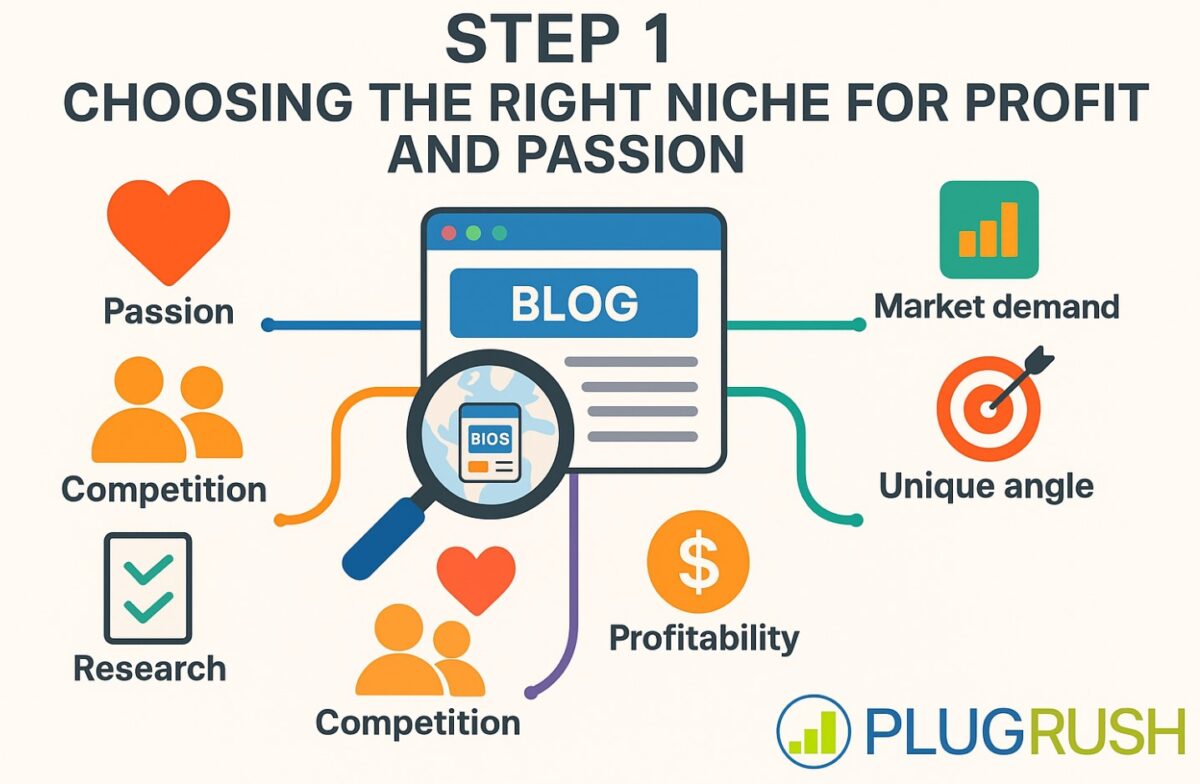
Start by identifying topics you’re passionate about. Passion will fuel your content creation, making it sustainable long-term. A genuine interest translates into engaging content. For example, if you are into sports betting, you could create a blog about sports and who users should bet on. By doing this, you could use some of the best gambling CPA networks for affiliates to earn money.
Next, research the market demand. Determine if there’s an audience for your chosen topic. Google Trends and social media insights can provide valuable data here.
Consider the competition. High competition can be intimidating, but it also signals demand. Focus on a unique angle to stand out in crowded niches.
Remember, profitability is key. Some niches are more lucrative than others. Find those that allow diverse monetization strategies.
Here’s how you can narrow down your options:
- Brainstorm a list of interests
- Assess personal expertise in each area
Once you have potential niches, evaluate them further:
- Analyze audience size and engagement potential
- Research monetization methods and success stories
Ultimately, the right niche is where passion meets market demand. Choose wisely, as this decision is foundational. Your niche will guide content creation and audience engagement. A well-chosen niche sets the stage for a thriving blogging journey.
Step 2: Setting Up Your Blog for Success
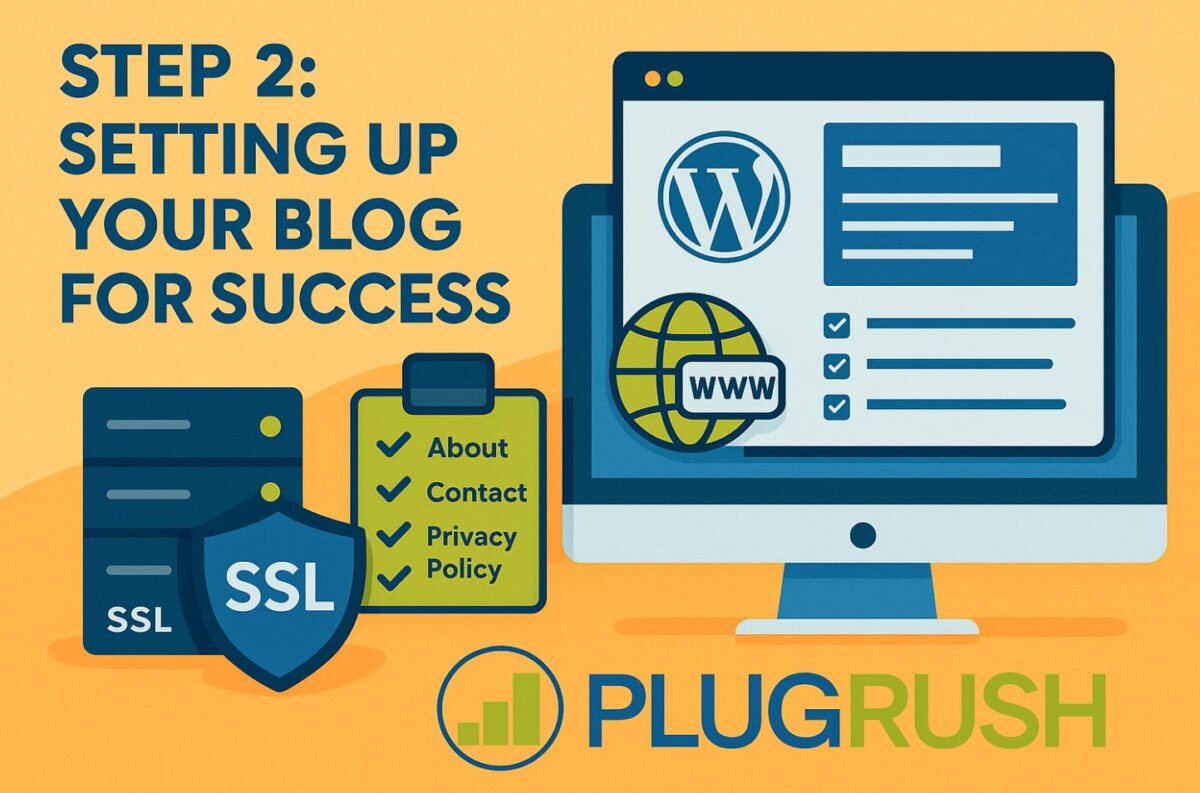
To succeed, setting up your blog properly from the start is crucial. Begin by selecting a reliable web host. This ensures your site is always accessible.
An intuitive blogging platform is essential. WordPress is popular for its versatility and ease of use. It offers thousands of themes and plugins.
Choose a domain name that reflects your niche. It should be short, memorable, and easy to spell. Avoid complicated words or long phrases.
Secure your website to protect data and build trust. An SSL certificate is vital for security.
Optimize your blog for speed. A fast-loading site improves user experience and boosts SEO rankings.
Set up essential pages. An ‘About’ page, ‘Contact’ page, and a ‘Privacy Policy’ page are must-haves.
Use a checklist to ensure nothing is overlooked:
- Select a reliable hosting provider
- Choose an intuitive blogging platform
- Opt for an SSL certificate for security
- Set up essential pages (About, Contact, Privacy Policy)
A solid foundation is key for any successful blog. With the right setup, you position your blog for growth and profitability.
Picking a Blogging Platform and Domain Name
Choosing the right blogging platform is vital. It influences how you create and manage content. WordPress is a top choice, offering flexibility with numerous plugins.
Think about ease of use and functionality. Ensure the platform supports future growth. Responsive design and SEO tools are essential.
Your domain name is your blog’s identity. It should be catchy and relevant to your niche. Consider using a .com extension for universal recognition.
Brainstorm several options before deciding. Use a domain checker to see availability. Avoid numbers and hyphens for simplicity.
Here’s a simple approach:
- Choose a platform like WordPress
- Ensure the domain name is easy and relevant
- Check domain name availability with a domain checker
Picking the right platform and domain sets the stage for your blog’s success.
Designing a User-Friendly and Attractive Blog
Design plays a critical role in user engagement. An appealing design retains visitors and encourages exploration. Choose a clean, professional theme that reflects your blog’s tone.

Consider usability. Navigation should be intuitive. Ensure menu links and buttons are easy to find and use.
Responsive design is non-negotiable. With mobile traffic on the rise, your blog must adapt seamlessly to screens of all sizes.
Incorporate visuals to enhance aesthetic appeal. Use images and videos to break up text and engage visitors.
Here are key design elements to consider:
- Select a clean, professional theme
- Ensure navigation is intuitive
- Prioritize responsive design
- Use visuals like images and videos
A well-designed blog enhances user experience and increases traffic retention. It sets a positive first impression and keeps visitors coming back for more.
Step 3: Creating High-Quality, Engaging Content
Creating content that captivates is vital for blog success. High-quality posts attract more readers and encourage sharing. Begin by knowing your audience and addressing their needs.
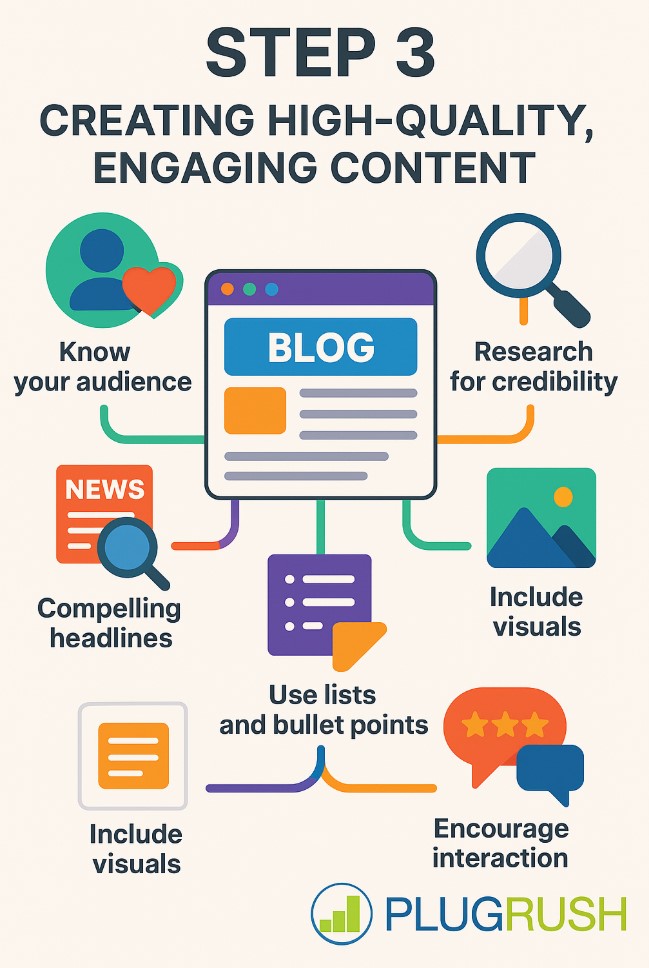
Research is crucial for credible content. Dive deep into your chosen topics to provide valuable insights. Present information clearly and concisely.
Compelling headlines grab attention. Craft headlines that spark curiosity but accurately represent the content. This boosts click-through rates.
Lists and bullet points enhance readability. Break down complex ideas into digestible chunks. This makes it easier for readers to absorb information.
Incorporate visuals like images, charts, and infographics. They enrich content and cater to visual learners. Ensure visuals are relevant and high-quality.
Interactivity retains reader interest. Encourage comments, shares, and discussions. This builds community and fosters loyalty.
Regularly update content to keep it fresh. Google favors updated information, and so do readers. Revisit old posts and refresh them periodically.
Here’s a checklist for quality content:
- Know your audience and address their needs
- Conduct thorough research for credibility
- Craft compelling headlines
- Use lists and bullet points for clarity
- Include relevant, high-quality visuals
- Encourage reader interaction
- Regularly update older posts
Your blog’s success hinges on engaging, informative content. Prioritize quality to build a loyal readership and increase visibility.
Content Planning and Editorial Calendars
Successful content creation requires strategic planning. An editorial calendar helps streamline the process and maintain consistency. It allows you to plan topics, set deadlines, and manage resources.
Begin by brainstorming content ideas relevant to your niche. Incorporate diverse formats like articles, lists, and interviews. Ensure a variety of content to engage different audience segments.
Schedule posts according to key dates and trends. Time-sensitive content can boost traffic during specific periods. Holidays and industry events offer unique opportunities.
Here’s a step-by-step approach:
- Use an editorial calendar for organization
- Brainstorm diverse content ideas
- Schedule posts around key dates and events
An editorial calendar keeps your content timely and relevant. It helps you stay organized and focused, paving the way for consistent blogging success.
Writing for SEO and Readers
Balancing SEO with readability enhances content visibility and engagement. Focus on strategically using keywords without compromising the user experience.
Optimize each post for search engines by incorporating relevant keywords. Place them naturally in headlines, subheadings, and throughout the text. Avoid keyword stuffing, which can harm readability and rankings.
Craft short, engaging paragraphs. Break content into sections with subheadings for improved scanning. This caters to both readers and search engines.
Link to relevant internal and external resources. Internal links guide readers through your site, while external ones add credibility. Proper linking improves SEO and enriches the user experience.
Here’s a quick guide:
- Use keywords naturally in headlines and text
- Craft concise, engaging paragraphs
- Break content into scannable sections
- Include internal and external links
Writing for both SEO and readers maximizes your blog’s reach. It builds authority and delivers value, helping you stand out in search results and engage effectively with your audience.
Step 4: Building and Growing Your Audience
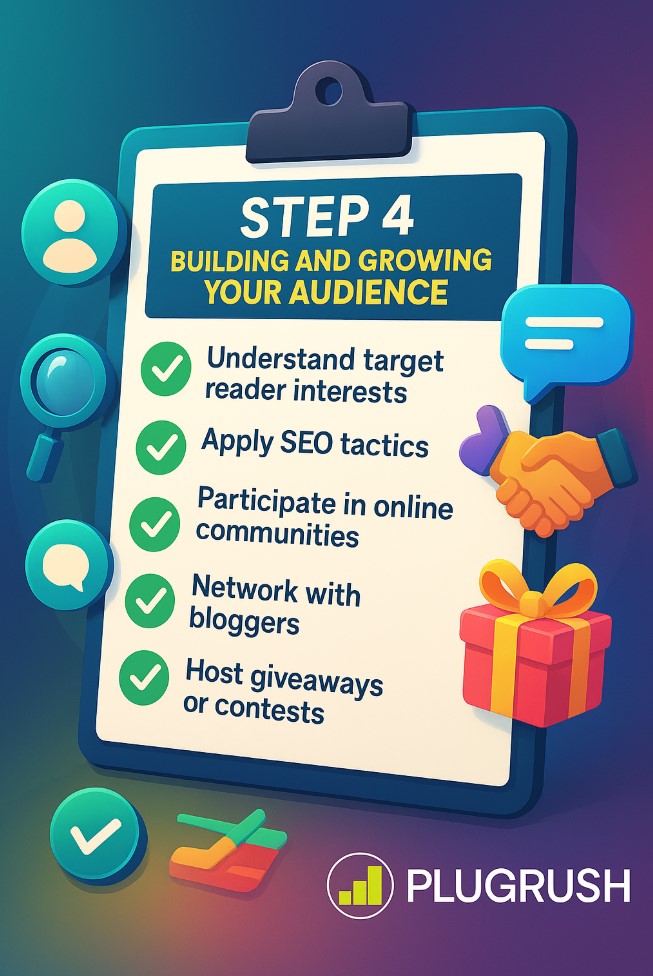
Growing your blog audience involves strategic efforts across several channels. Start by understanding your target readers. Tailor your content to their interests and preferences, creating value in every post.
Utilize SEO techniques to increase organic traffic. Conduct keyword research to optimize posts, improving search engine rankings. This attracts readers actively searching for topics within your niche.
Engage in online communities related to your topic. Forums, social media groups, and comment sections offer opportunities to connect and share your expertise. Contribute meaningfully to discussions to build credibility.
Networking with other bloggers opens doors to collaboration. Guest posts can reach new audiences and lend authority to your platform. Establish mutually beneficial relationships to expand your reach.
Host giveaways or contests to encourage engagement and sharing. Incentives can drive traffic and excitement around your blog. Ensure rules and rewards align with your audience’s interests.
Regularly analyze audience data to refine strategies. Use tools like Google Analytics to track visitor behavior and preferences. Adapting based on insights can enhance effectiveness.
Effective audience-building strategies:
- Understanding and catering to target reader interests
- Applying SEO tactics for increased search visibility
- Participating in relevant online communities
- Networking with peer bloggers for broader reach
- Hosting engaging giveaways or contests
Investing in audience growth yields long-term benefits. A dedicated readership translates to more opportunities and increased income potential.
Leveraging Social Media for Blog Growth
Social media is a powerhouse for driving blog traffic. Select the right platforms where your audience is most active. Each platform caters to different demographics and content styles.
Share blog content consistently across social channels. Use eye-catching visuals and compelling captions to boost engagement. Timely, regular posting builds anticipation and loyalty.
Engage with followers by responding to comments and messages. Interaction fosters community and encourages more sharing. Acknowledging your audience’s input demonstrates appreciation.
Analyze social media metrics to understand performance. Track likes, shares, and comments to gauge content impact. Insights can shape future strategies for better results.
Steps to leverage social media:
- Choose platforms where your audience is present
- Post consistently with engaging visuals
- Interact with followers regularly
- Analyze metrics to refine strategies
Social media amplifies blog visibility and helps cultivate a vibrant, interactive community.
Building an Email List for Long-Term Success
An email list is a valuable asset for bloggers. It offers direct access to your audience and can drive consistent traffic. Focus on building a list from day one.
Create a compelling incentive to encourage sign-ups. Free resources like e-books, checklists, or exclusive content can attract subscribers. Ensure the offer resonates with your blog’s niche and audience.
Regularly send valuable, relevant content to your subscribers. Newsletters, updates, and personalized messages keep your audience engaged. Maintain consistency in frequency and quality.
Segment your email list to tailor content to different subscriber groups. Personalization boosts open and conversion rates. Addressing specific reader needs enhances connection and results.
Building a successful email list involves:
- Offering an appealing incentive for sign-ups
- Providing valuable, consistent content
- Segmenting the list for personalized communication
An engaged email list strengthens your blog’s influence and revenue potential.
Step 5: Monetization Strategies to Earn Money Blogging
Turning your blog into a revenue stream involves multiple strategies. It’s vital to select the right combination that aligns with your content and audience.
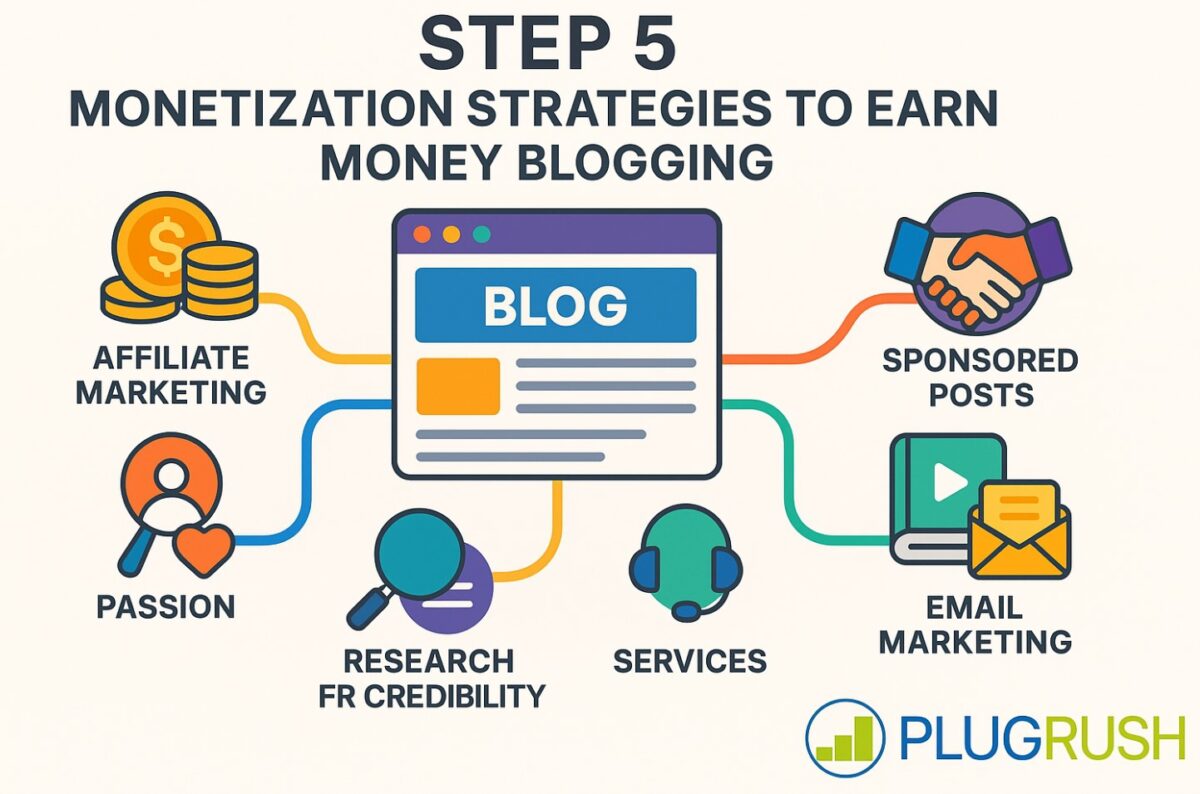
Start with affiliate marketing, a popular method among bloggers. By promoting products and earning commissions, you integrate seamless revenue generation with regular content. Be sure to research affiliate networks, or look at the top 10 affiliate marketing programs.
Next, consider display ads and ad networks. They offer passive income by placing ads on your site. As your traffic grows, so does your earning potential with minimal ongoing effort.
Sponsored posts and brand collaborations also bring in revenue. You’ll work directly with brands, offering authenticity and valuable exposure to products your audience might love.
Consider creating and selling digital products. E-books, courses, and workshops offer high-value exchanges, leveraging your knowledge for profit. This strategy turns expertise into merchandise.
Offering services like coaching or consulting can be lucrative. Sharing niche knowledge on a one-to-one basis can command premium pricing, providing a more personalized income approach.
Subscription-based models are another avenue. By offering exclusive content to paying members, you create a stable income while fostering a community of dedicated readers.
Common blog monetization strategies:
- Affiliate marketing for commission earnings
- Display ads for passive income
- Sponsored posts for direct collaboration
- Selling digital products for knowledge monetization
- Offering services for personalized engagement
- Subscription models for community building
With these methods, the blend is key. Choose what fits your expertise and audience needs, then refine for maximum impact.
Affiliate Marketing: How to Make Money Promoting Products
Affiliate marketing empowers you to earn commissions by recommending products. Start by joining affiliate programs related to your blog’s niche. Many companies offer affiliate partnerships; choose those your readers trust.
Incorporate affiliate links naturally within your content. Craft reviews, tutorials, or blog posts that showcase products in real-life scenarios. Authenticity is crucial, as readers appreciate honest opinions.
Use disclosure statements for transparency. It’s essential to inform your audience that some links may earn you a commission. Honesty builds trust and maintains credibility.
Track the performance of affiliate links. Use tools or platforms that provide analytics on clicks and conversions. Understanding which products resonate helps refine your approach.
Steps to optimize affiliate marketing:
- Join relevant affiliate programs
- Integrate links naturally in content
- Maintain transparency with disclosures
- Monitor link performance for optimization
Affiliate marketing can be a significant income stream with the right strategy and execution.
Display Ads and Ad Networks: Passive Income for Bloggers
Display ads offer bloggers a hands-off income source. Once set up, they generate revenue as visitors view or interact with the ads on your site. It’s a straightforward way to monetize traffic.
Choose an ad network that suits your content and audience. Google AdSense is a popular choice, but there are alternatives. Consider factors like payout rates and control over ad appearance.
Position your ads strategically for effectiveness. Sidebar placements or in-content ads can achieve better engagement. Experiment with placements to identify what works best for your site.
Monitor ad performance regularly. This helps optimize settings and improves earnings over time. Metrics like click-through rates provide valuable insights into visitor behavior.
Key points for maximizing display ads:
- Select a suitable ad network
- Optimize ad placements on your site
- Continuously monitor performance
Display ads provide a reliable income stream with minimal maintenance, freeing you to focus on creating content.
Sponsored Posts and Brand Collaborations
Sponsored posts enable direct collaboration with brands. These partnerships often involve writing articles or creating content that highlights a brand’s products or services. It’s a win-win for both parties, providing you income and brands exposure.
Choose brands that align with your blog values and resonate with your audience. Authentic connections ensure the partnership benefits all involved. Reach out proactively or leverage platforms that connect bloggers with brands.
Set clear expectations regarding deliverables and compensation. Understand what the brand hopes to achieve and negotiate terms that reflect your time and influence.
Deliver high-quality content that genuinely showcases the brand. Unique narratives and compelling storytelling can drive engagement, enhancing the post’s impact.
Steps to effective sponsored posts:
- Align with suitable brands
- Define clear expectations and compensation
- Craft engaging, high-quality content
Sponsored posts can significantly bolster your blogging revenue while enriching content variety.
Selling Digital Products: Ebooks, Courses, and More
Creating digital products transforms your expertise into profitable offerings. Ebooks, online courses, and templates are just a few examples. They offer a scalable way to extend your reach and monetize knowledge.
Identify topics that address your audience’s pain points or interests. Research what resonates most and where your expertise fills a gap. This ensures your product targets demand effectively.
Develop high-quality, user-friendly products. Use professional design and clear, informative content. A polished product boosts credibility and encourages positive reviews.
Market your products through your blog and email list. Promote them in relevant posts and consider offering limited-time discounts to stimulate demand.
Essential steps for selling digital products:
- Pinpoint audience needs and product ideas
- Develop quality, professionally designed products
- Promote effectively through your channels
Digital products allow you to build an asset-based income stream, leveraging existing content and expertise.
Offering Services: Coaching, Consulting, and Freelance Writing
Services like coaching or consulting capitalize on your expertise. Offering one-on-one guidance provides value to clients seeking personalized assistance. It’s an opportunity to earn from your unique insights and experience.
Define the services you offer clearly. Specify the scope, pricing, and any unique selling points. A well-defined offering helps attract the right clients.
Market these services on your blog and through your network. Use testimonials and case studies to demonstrate value. They provide potential clients with confidence in your capabilities.
Set up an efficient onboarding process for new clients. A structured system streamlines service delivery and enhances client experience.
Considerations for offering services:
- Clearly define service scope and pricing
- Market effectively using testimonials
- Establish efficient client onboarding
Offering services taps into personal connections and showcases your expertise in practice.
Memberships and Subscriptions: Recurring Revenue Models
Memberships and subscriptions offer a steady, recurring income. By providing members with premium content or exclusive resources, you create value that encourages ongoing participation.
Develop content that justifies the cost of membership. This could include behind-the-scenes insights, advanced tutorials, or community support forums. Membership should enhance the user experience significantly.
Promote the benefits of your membership program clearly. Articulate why potential subscribers would value the exclusive offerings. Use your existing channels to introduce and highlight membership perks.
Regularly update and enrich the member experience. New content or features keep the membership appealing and demonstrate ongoing commitment to member satisfaction.
Strategies for successful membership programs:
- Offer valuable, exclusive content
- Clearly promote membership benefits
- Continuously update and enrich offerings
Membership models foster community and ensure consistent monthly income, contributing to blog growth and sustainability.
Step 6: Advanced Blog Monetization Tactics
As your blog matures, exploring advanced monetization tactics becomes crucial. Diversifying income streams enhances financial stability and maximizes your earning potential. By tapping into various sources, you secure a buffer against industry fluctuations.
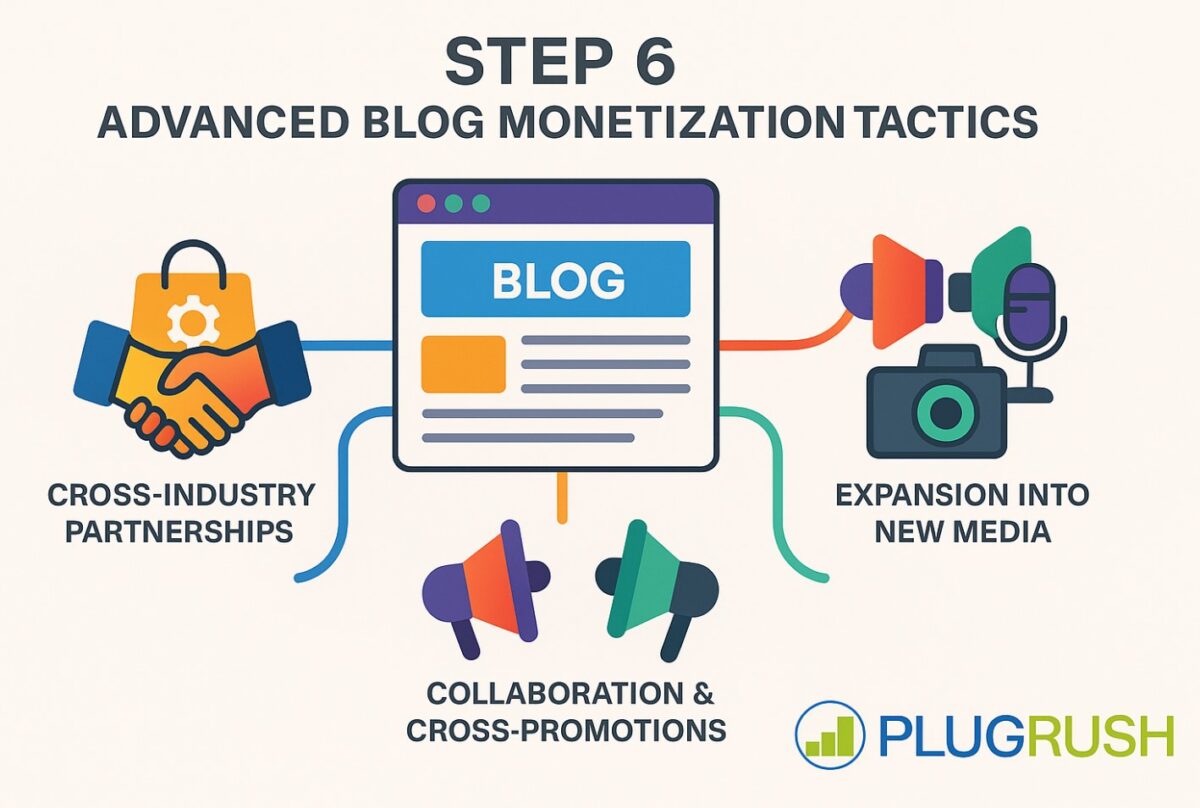
Consider partnerships outside traditional blogging realms. Collaborating with tech platforms or e-commerce can introduce lucrative opportunities. This approach broadens your audience base and revenue streams.
Engage in cross-promotions with other bloggers or influencers. This method boosts exposure and opens new monetization channels. It also fosters community connections and peer support.
Expand your content into new media forms like video or podcasts. This diversification not only attracts different audience segments but also opens additional monetization avenues.
Creative monetization strategies:
- Cross-industry partnerships
- Collaboration and cross-promotions
- Expansion into new media
Tailoring these tactics to your niche strengthens your blog’s growth and income potential, keeping it vibrant and adaptable in a dynamic digital landscape.
Diversifying Income Streams for Stability
Relying on a single revenue source can risk financial instability. Diversifying streams mitigates this risk and increases earning potential.
Explore various monetization methods. This could include affiliate marketing, digital product sales, and sponsored content. Each option should complement your existing blog focus.
Invest in building multiple channels. For example, service offerings like consulting or speaking engagements add another layer of income.
Implement these strategies incrementally. A gradual approach ensures manageable growth, allowing you to refine methods and achieve sustainable outcomes.
Income diversification tactics:
- Engage multiple monetization methods
- Expand into service-based offerings
- Implement incremental strategies
Balancing diverse sources fortifies your income, making it resilient to changes in the blogging ecosystem.
Leveraging Video, Podcasts, and New Media
Expanding your blog into video and podcasts offers fresh monetization potential. These formats attract diverse audiences, providing new engagement opportunities.
Create video content to complement your blog. YouTube channels or social media stories highlight your personality and expertise, enriching your brand.
Podcasts allow deeper audience connections. Explore topics from your blog, featuring interviews with experts in your field. This depth engages listeners and attracts sponsorship.
Explore monetization options unique to these media. Ads in videos or sponsored podcast segments add revenue, broadening your financial landscape.
Monetize new media:
- Develop complementary video content
- Launch podcasts with unique insights
- Use ad placements in videos or podcasts
Adapting to new media not only enhances your content but also diversifies and stabilizes income, ensuring your blog’s lasting success.
Step 7: Optimizing and Scaling Your Blogging Business
To elevate your blogging venture, focus on optimization and scaling. Regularly assessing and refining processes ensures your blog’s growth trajectory. Begin by scrutinizing data to uncover performance insights. These insights guide informed decision-making and strategic adjustments.
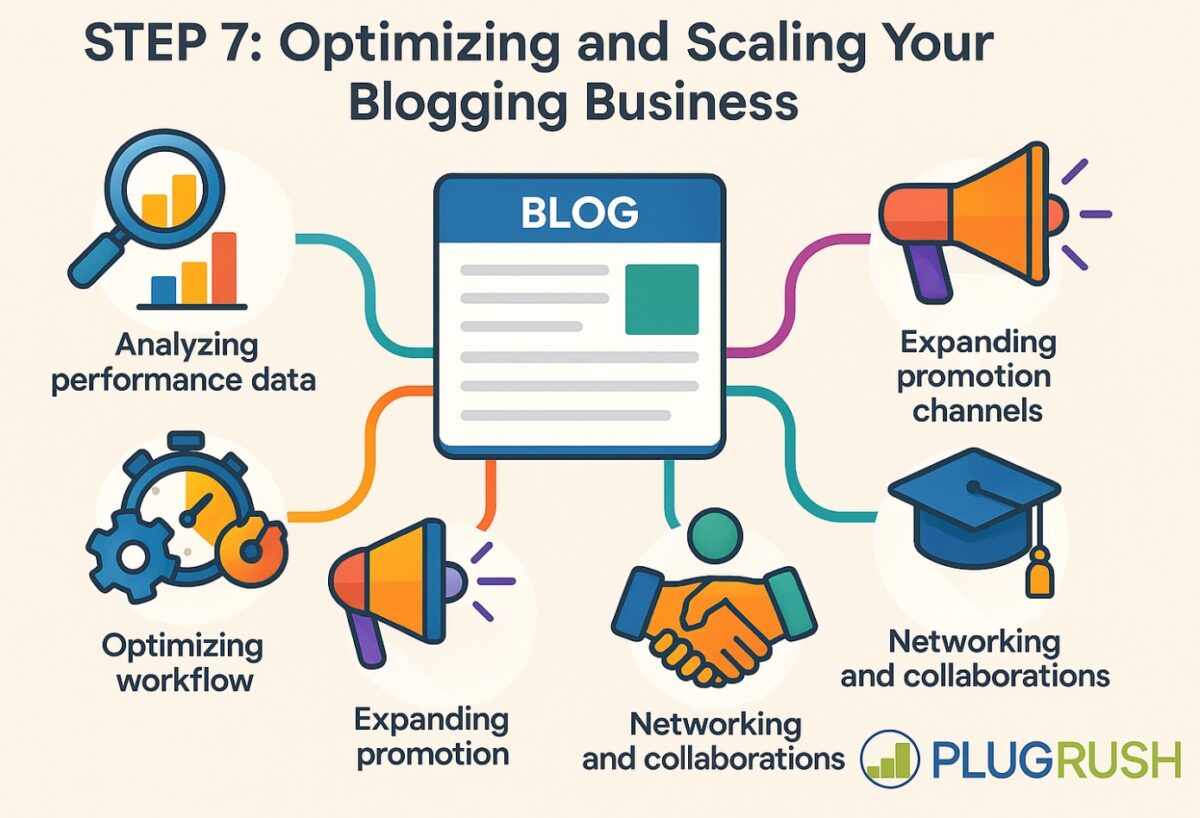
Next, enhance your workflow efficiency. Streamlined operations leave room for scaling activities without sacrificing quality. This may involve adopting new tools or automating routine tasks to save time.
Expand your content’s reach by experimenting with new promotion channels. You can also get free traffic by trading traffic using the Trade Program from PlugRush. Diversified platforms increase audience size and engagement. Explore untapped markets and trends to stay relevant.
Invest in skills upgrade for yourself and your team. Continuous learning keeps you ahead in the dynamic digital space. Mastering new skills boosts your blog’s competitive edge.
Consider networking with industry peers and influencers. Collaboration expands your blog’s reach and introduces fresh perspectives. Community engagement often leads to innovative ideas and partnerships.
Optimization strategies:
- Scrutinize performance metrics
- Streamline workflows
- Expand promotional avenues
Scaling tactics:
- Skills upgrade and learning
- Industry networking
- Explore new trends
Implementing these strategies propels your blog into a sustainable growth phase, fostering long-term success.
Analyzing Performance and Refining Strategies
Constantly monitoring performance is crucial for blogging excellence. Use analytics tools to track audience behavior and preferences. This data illuminates which content resonates and which needs improvement.
Set clear performance benchmarks to measure against. Understand traffic patterns, engagement levels, and conversion rates to gauge success. These metrics inform your strategy tweaks.
Evaluate your monetization efforts. Track which revenue streams are thriving or need adjustment. Responsive refinement maximizes your income opportunities.
Regular reviews keep your strategies relevant and effective. Adapt quickly to shifts in audience interests or market conditions.
Key Metrics to Monitor:
- Traffic and page views
- Audience engagement levels
- Conversion and monetization rates
Through diligent analysis and timely strategy refinement, you can maintain and boost your blog’s performance and profitability.
Outsourcing and Building a Team
As your blog grows, consider delegating tasks to extend your reach. Outsourcing non-core activities allows you to focus on strategic growth and quality content.
Identify tasks suitable for delegation. These could include content creation, social media management, or technical updates. Relinquishing these frees valuable time for big-picture planning.
Build a team of skilled professionals. Seek those whose expertise complements your vision. A well-rounded team enhances both quality and efficiency.
Foster a collaborative working environment. Encouragement and clear communication help maintain motivation and productivity.
Delegation strategies:
- Identify non-core tasks for outsourcing
- Engage skilled professionals
- Foster a collaborative and motivated team
Through strategic delegation and team-building, you equip your blogging business to handle increased demands, ensuring a seamless path to growth.
Common Challenges and How to Overcome Them
Blogging presents various challenges that can hinder your path to success. However, each obstacle offers an opportunity for growth and learning. Let’s explore common hurdles and practical ways to overcome them.
Firstly, maintaining consistent content creation can be daunting. Balancing quality with a regular posting schedule is key. Develop an editorial calendar to plan topics and deadlines. This approach aids in sustaining a steady content flow.
Secondly, struggling to grow your audience is a frequent issue. Enhance visibility through strategic use of SEO and social media engagement. Authentic engagement with your audience builds trust and long-term loyalty.
Monetization can also pose challenges. Experimenting with diverse income streams mitigates this. Adopt multiple revenue models to ascertain what works best for your niche.
Technical difficulties might arise as your site scales. Invest in reliable hosting and seek professional help for technical issues. Ensuring smooth website operation is crucial for retention.
Challenges and Solutions:
- Consistent content creation: Use an editorial calendar
- Audience growth: Boost SEO and engage authentically
- Monetization struggles: Diversify income streams
- Technical issues: Ensure robust hosting and professional help
By addressing these challenges proactively, you can optimize your blogging strategy for sustained success and profitability.
Frequently Asked Questions About Earning Money Blogging
Embarking on a blogging journey raises numerous questions, especially when monetization is involved. Let’s address some frequent queries.
How long does it take to start making money?
Blogging income depends on multiple factors including niche, strategy, and effort. Typically, it may take several months to see consistent income.
What are the best monetization strategies for beginners?
Beginners often succeed with affiliate marketing and ad networks. These methods require minimal investment and leverage existing content.
How can I increase blog traffic quickly?
Driving traffic quickly can be achieved through targeted social media campaigns and SEO optimization. Engaging with your audience can foster organic growth.
Is email marketing effective for bloggers?
Yes, email marketing is a powerful tool for nurturing an audience. Building a subscriber list promotes direct communication and increased traffic.
Common Beginner Mistakes:
- Neglecting SEO optimization
- Focusing solely on monetization without building audience trust
Essential Blogging Tools:
- Google Analytics for tracking performance
- Email marketing platforms like Mailchimp for audience engagement
With these answers, you can navigate challenges and optimize your path to earning money through blogging effectively.
Final Thoughts: Your Roadmap to Make Money Online Blogging
Earning money through blogging requires dedication and strategic planning. It’s crucial to stay adaptable to new trends and technologies. Embrace each opportunity to refine your skills and strengthen your blog’s presence.
Consistency is key. Regular content creation and audience engagement foster growth. Set achievable goals and celebrate small victories to maintain motivation along the journey.
Exploring diverse monetization methods can bolster financial stability. From affiliate marketing to digital products, find what aligns with your blog’s niche and audience interests.
Key Points to Remember:
- Prioritize quality and reader engagement
- Experiment with various content formats
- Keep learning and adapting to changes
With these strategies, you’re equipped to turn your blog into a successful online venture. Embrace the process, and watch your blog thrive.




